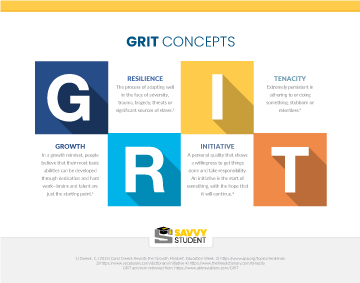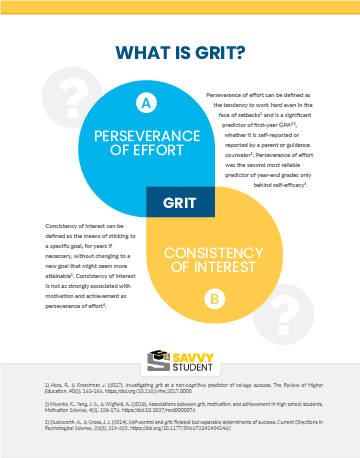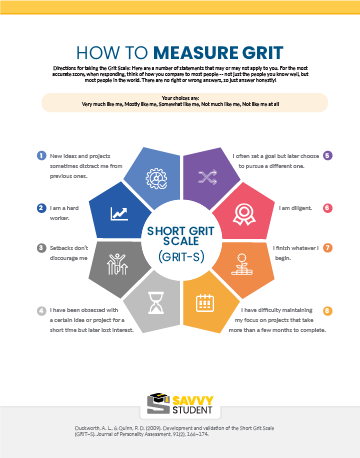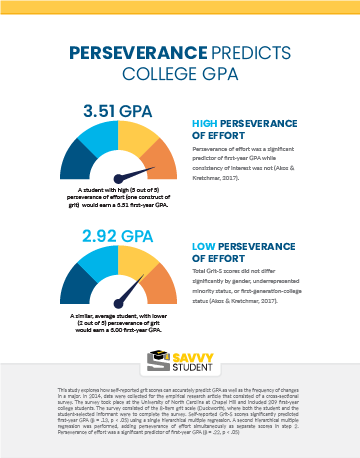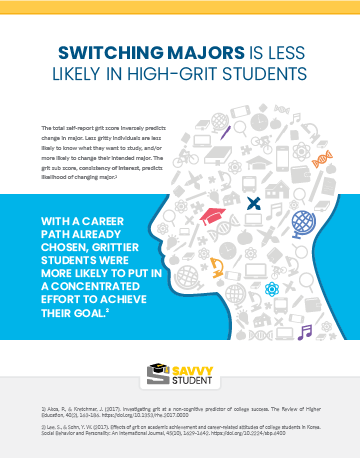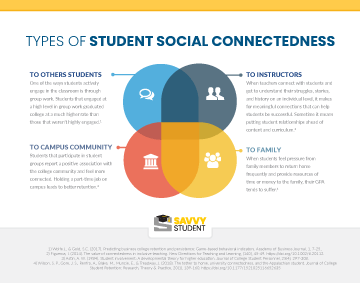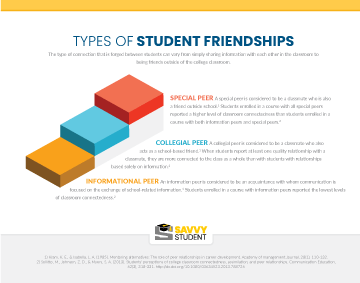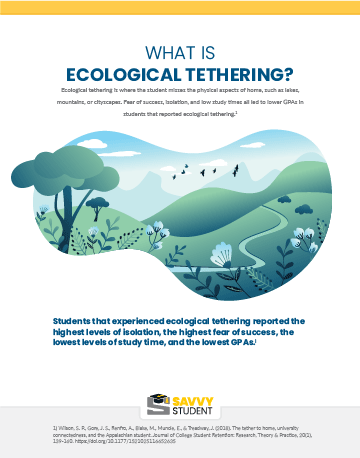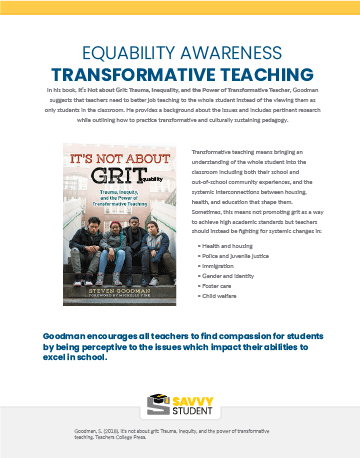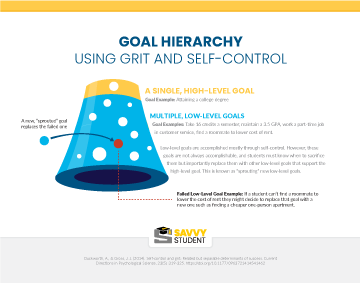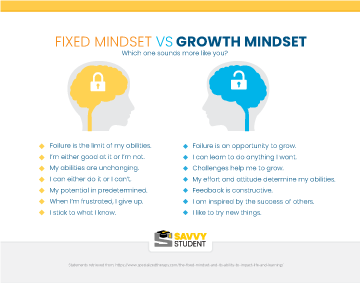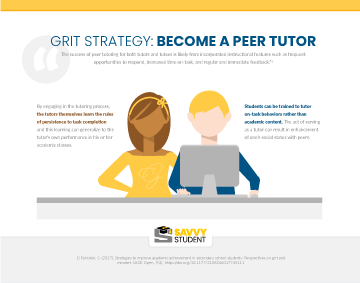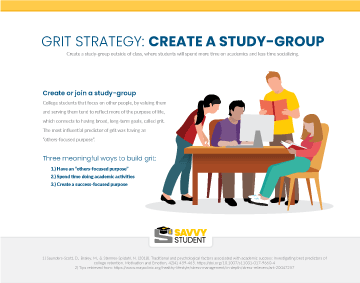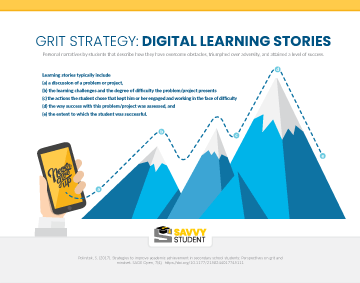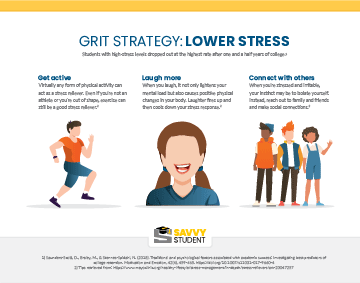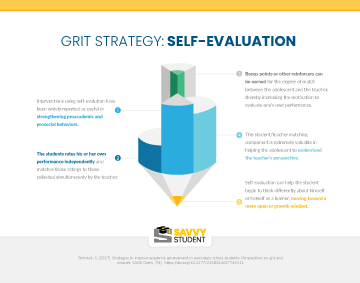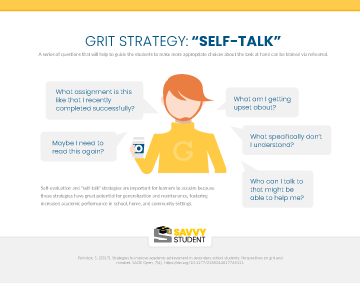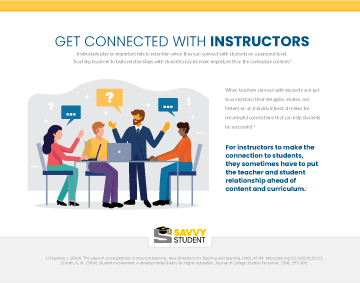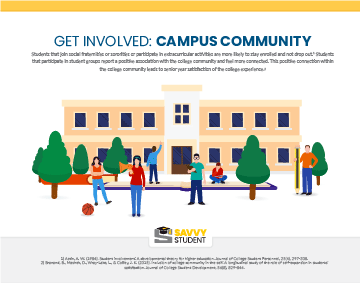The following infographics and illustrations have been developed to help explain the basic concepts of grit and social connectedness and how they affect student retention in post-secondary environments including two-year, and four-year colleges. Sharing the research-based graphics within your college system with instructors, administrators, staff, and other college employees helps build a better understanding of what grit and social connectedness are and why you would want to promote these concepts to college students. The graphics are geared for sharing on social media, distributing on student learning management systems (LMS) such as Blackboard, Schoology, Google Classroom, and Desire2Learn (D2L), and can also be implemented as part of a college employee’s professional development.
Getting to know grit and social connectedness
The basic concept of grit is covered in an acronym – G.R.I.T. Growth refers to the concept of growth mindset. Resilience is all about bouncing back when things don’t go your way. Taking initiative is important because to finish something, you have to first start it. And lastly, tenacity is the idea of pure stubbornness rearing its beautiful head.
View PDF
Researchers often view human grit as the overlap of two main constructs. A person’s perseverance of effort and their consistency of interest collide to define the underlying concept that we call grit.
View PDF
By completing a short, self-administered, questionnaire, you are able to determine where you fall on the linear grit scale. Score a one and you lack grit, score a five and you join the ranks of the grittiest individuals. Give it a shot for yourself: angeladuckworth.com/grit-scale/
View PDF
Researchers recently unlocked one of the variables in attaining a higher college GPA. The key lies in a student’s perseverance of effort. A recent study links a high perseverance of student effort to a GPA that is nearly .6 points higher than students that reported a low perseverance of effort in their own academics.
View PDF
Recent research has brought to light that college students who report higher consistency of interest scores on the grit scale are less likely to change majors while enrolled in a post-secondary institution.
View PDF
College students experience four different types of social connectedness. A simple breakdown shows they are connected to other students, instructors, campus community and their families.
View PDF
College student friendships can be broken down into three categories. An informational peer is someone that a student simply shares classroom information with. A collegial peer takes it one step further by creating a classroom friendship. A special peer is someone that becomes a friend inside and outside of the classroom.
View PDF
Students often form a special bond with their home environment. We call this ecological tethering and it can negatively affect their academic performance.
View PDF
Two types of athletic motivation include task-oriented and ego-oriented. Task-oriented athletes tend to have higher athletic social connectedness and better well-being.
View PDF
Strategies to grow grit and improve social connectedness
To help students become grittier and stronger connected socially, college employees are encouraged to use the strategies and techniques portrayed in the infographics and illustrations. Each graphic is backed by empirical research and provides a practical and tangible strategy that can be used with college students. Some of the strategies included are goal hierarchy, building a growth mindset, becoming a peer tutor, creating a study group, offering digital learning stories, lowering stress, self-evaluation, self-talk, connecting with college instructors, and getting involved in the campus community.
Steven Goodman’s book It’s Not about Grit: Tramuma, Inequality, and the Power of Transformative Teacher shows us the value of teaching to the whole student and the importance of teachers rallying for systemic changes instead of promoting grit in racially diverse, poverty-stricken school districts.
View PDF
All goals are not created equal. A single, high-level goal is supported by many lower-level goals. To attain the high-level goal, students must demonstrate grit, while at the same time knowing when to sacrifice and replace low-level goals in any given situation.
View PDF
Students that think “that is too hard, I can’t learn how to do that” are demonstrating a fixed mindset. With the encouragement of instructors and other college employees we can as a team, help migrate students to an “I’ll never know if I don’t try” growth mindset.
View PDF
Whether it is an academic subject or an on-task behavior, becoming a peer tutor to help other students has a positive effect on one’s grit. Help others and help yourself at the same time.
View PDF
One of the biggest influences on bolstering student grit has to do with putting other people’s purpose before your own. One way of doing this is to start or join a study group. By doing so, you’ll contribute your knowledge to the group while at the same time improving your own grit.
View PDF
Digital learning stories about people that have to overcome obstacles can be shared with students. A recent study shows that students that listened to digital learning stories outlasted their peers in college semesters that didn’t engage in the stories.
View PDF
Lowering stress and bolstering grit go hand-in-hand according to a 2018 student focused on student retention. Get active, laugh more, and connect with others are three of many ways suggested by the Mayo Clinic.
View PDF
For a better understanding of perspective, students can be encouraged to evaluate their own school work. By doing this repeatedly, students begin to view projects from the instructor’s perspective and they reportedly improve their academic performance and grit simultaneously.
View PDF
To help build grit, students should be encouraged to ask themselves questions when they hit academic obstacles. This exercise not only helps in the college environment but at home and community as well.
View PDF
Instructors should be striving to connect with their students on a personal level. Even if this means sometimes sacrificing content and curriculum to gain the student connection.
View PDF
Students that participate in extracurricular activities are more likely to stay enrolled and generally have a more satisfying college experience. Most schools offer a variety of student activities and events.
View PDF




